
Concept explainers
(a)
Interpretation:
All the chiral centers in the molecule are to be identified, and it is to be determined whether the molecule is meso.
Concept introduction:
A chiral center is a tetrahedral stereocenter. The atom at the chiral center must be
Answer to Problem 5.39P
The given molecule does not have any chiral center, and it is not a meso compound.
Explanation of Solution
The structure of the given molecule is

A chiral center must be an
The given molecule is determined as not a meso compound as it has no chiral center.
(b)
Interpretation:
All the chiral centers in the molecule are to be identified, and it is to be determined whether the molecule is meso.
Concept introduction:
A chiral center is a tetrahedral stereocenter. The atom at the chiral center must be
Answer to Problem 5.39P
The given molecule has one chiral center marked with
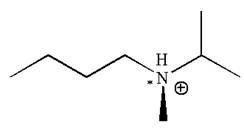
Explanation of Solution
The structure of the given molecule is
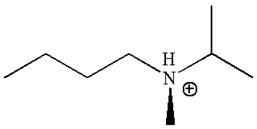
In this molecule, the nitrogen atom is a chiral center bonded to four different groups

As this molecule has only one chiral center, it cannot possess any symmetry, and hence, it is not a meso compound.
The chiral center in the given molecule is identified, and it is determined that the molecule is not a meso compound.
(c)
Interpretation:
All the chiral centers in the molecule are to be identified, and it is to be determined whether the molecule is meso.
Concept introduction:
A chiral center is a tetrahedral stereocenter. The atom at the chiral center must be
Answer to Problem 5.39P
The given molecule has one chiral center marked with

Explanation of Solution
The structure of the given molecule is
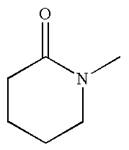
The molecule consists of a ring made up of five carbon atoms and one nitrogen atom. The nitrogen atom is bonded to three different groups having the pyramidal shape and a non-bonded electron pair pointing to the unoccupied tetrahedral corner. This makes the nitrogen a chiral center.
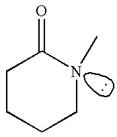
As this molecule has only one chiral center, it cannot possess any symmetry, and hence, it is not a meso compound. The chiral center is marked as

The chiral center in the given molecule is identified, and it is determined that the molecule is not a meso compound.
(d)
Interpretation:
All the chiral centers in the molecule are to be identified, and it is to be determined whether the molecule is meso.
Concept introduction:
The molecule with at least one chiral center having no plane of symmetry is called a chiral molecule. A chiral center is a tetrahedral stereocenter. The atom at the chiral center must be
Answer to Problem 5.39P
The given molecule has no chiral center, and it is not a meso compound.
Explanation of Solution
The structure of the given molecule is
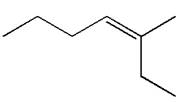
A chiral center must be an

Therefore, these carbon atoms are also not chiral centers. As there are no chiral centers, the molecule is not a meso compound.
The given molecule is determined as not a meso compound as it has no chiral center.
(e)
Interpretation:
All the chiral centers in the molecule are to be identified, and it is to be determined whether the molecule is meso.
Concept introduction:
A chiral center is a tetrahedral stereocenter. The atom at the chiral center must be
Answer to Problem 5.39P
The molecule has two chiral centers marked with

It is not a meso compound.
Explanation of Solution
The structure of the given molecule is
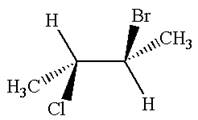
The given molecule possesses two chiral carbons. One carbon is bonded to four different groups,
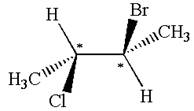
The molecule does not have symmetry plane; hence, it is not a meso compound.
The chiral centers in the given molecule are identified, and it is determined that the molecule is not a meso compound.
(f)
Interpretation:
All the chiral centers in the molecule are to be identified, and it is to be determined whether the molecule is meso.
Concept introduction:
A chiral center is a tetrahedral stereocenter. The atom at the chiral center must be
Answer to Problem 5.39P
The molecule has two chiral centers marked with

Explanation of Solution
The structure of the given molecule is
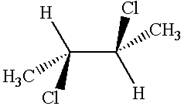
The given molecule possesses two chiral carbons bonded to four different groups,
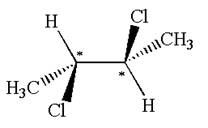
The molecule has no plane of symmetry, and hence, it is not a meso compound.
The chiral centers in the given molecule are identified, and it is determined that the molecule is not a meso compound.
(g)
Interpretation:
All the chiral centers in the molecule are to be identified, and it is to be determined whether the molecule is meso.
Concept introduction:
The molecule with at least one chiral center having no plane of symmetry is called a chiral molecule. A chiral center is a tetrahedral stereocenter. The atom at the chiral center must be
Answer to Problem 5.39P
The molecule has two chiral centers marked with
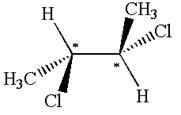
Explanation of Solution
The structure of the given molecule is
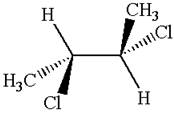
The given molecule possesses two chiral carbons bonded to four different groups,
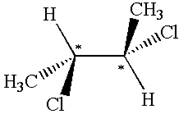
The molecule has no symmetry plane, and hence, it is not a meso compound.
The chiral centers in the given molecule are identified, and it is determined that the molecule is not a meso compound.
(h)
Interpretation:
All the chiral centers in the molecule are to be identified, and it is to be determined whether the molecule is meso.
Concept introduction:
The molecule with at least one chiral center having no plane of symmetry is called chiral molecule. A chiral center is a tetrahedral stereocenter. The atom at the chiral center must be
Answer to Problem 5.39P
The given molecule has one chiral center marked with

Explanation of Solution
The structure of the given molecule is

The molecule consists of a ring made up of four carbon atoms and one oxygen atom with a substituted methyl group. The carbon having the methyl substituent is a chiral center as it has four different groups bonded.

The molecule does not possess any symmetry plane; hence, it is a chiral molecule.
The chiral center in the given molecule is identified, and it is determined that the molecule is not a meso compound.
Want to see more full solutions like this?
Chapter 5 Solutions
ORG.CHEM W/TEXT+SOLU.MANUAL
- How many asymmetric/chiral centers are present in the molecule below?arrow_forwardFor each molecule below, identify its functional groupsand how many chiral centers it contains.arrow_forwardDetermine the # of chiral centers. Determine the most stable chair conformation then indicate which are equatorial and which are axial.arrow_forward
- Consider molecules with more than one chiral center. Consider 2,3-dyhdroxybutanoic acid. a. How many chiral centers does it have? b. Which ones? c. Reproduce the structure and encircle the four groups, which are linked to each chiral carbon.arrow_forwardDetermine how many chiral centers are there?arrow_forwardDraw two possible configurations at the given compound's (in the picture) 2 chiral centers.arrow_forward
 Organic Chemistry: A Guided InquiryChemistryISBN:9780618974122Author:Andrei StraumanisPublisher:Cengage Learning
Organic Chemistry: A Guided InquiryChemistryISBN:9780618974122Author:Andrei StraumanisPublisher:Cengage Learning Macroscale and Microscale Organic ExperimentsChemistryISBN:9781305577190Author:Kenneth L. Williamson, Katherine M. MastersPublisher:Brooks ColeChemistry: Matter and ChangeChemistryISBN:9780078746376Author:Dinah Zike, Laurel Dingrando, Nicholas Hainen, Cheryl WistromPublisher:Glencoe/McGraw-Hill School Pub Co
Macroscale and Microscale Organic ExperimentsChemistryISBN:9781305577190Author:Kenneth L. Williamson, Katherine M. MastersPublisher:Brooks ColeChemistry: Matter and ChangeChemistryISBN:9780078746376Author:Dinah Zike, Laurel Dingrando, Nicholas Hainen, Cheryl WistromPublisher:Glencoe/McGraw-Hill School Pub Co World of ChemistryChemistryISBN:9780618562763Author:Steven S. ZumdahlPublisher:Houghton Mifflin College Div
World of ChemistryChemistryISBN:9780618562763Author:Steven S. ZumdahlPublisher:Houghton Mifflin College Div World of Chemistry, 3rd editionChemistryISBN:9781133109655Author:Steven S. Zumdahl, Susan L. Zumdahl, Donald J. DeCostePublisher:Brooks / Cole / Cengage Learning
World of Chemistry, 3rd editionChemistryISBN:9781133109655Author:Steven S. Zumdahl, Susan L. Zumdahl, Donald J. DeCostePublisher:Brooks / Cole / Cengage Learning




